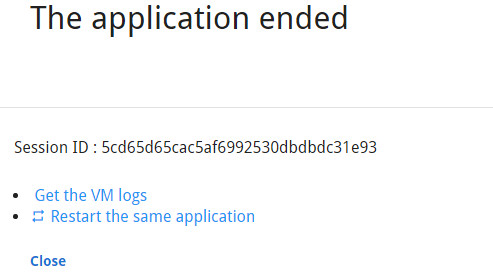When you run an application, the Genero Application Server (GAS) creates separate log files for its dispatchers, proxies, and the Dynamic Virtual Machines (DVMs) started by those proxies. These files may be viewed for troubleshooting.
- A log file is generated for each dispatcher. This log file captures incoming requests, the starting of proxies, responses sent, and system error messages.
- A log file is generated for each proxy started. A separate log file is generated for each proxy started.
- A log file is generated for each DVM started. DVM standard error and standard output are sent to the dedicated DVM log files.
When in development mode, the ending page for a Genero Web Client for JavaScript (GWC-JS) Web application contains a link to the DVM log file.

Figure 1. Example GWC-JS application ended page
Log file names
- httpdispatch.log
- uaproxy-<session-id>.log
- gwsproxy-<group>-<app>.log
- vm-<session-id>.log
- vm-<group>-<app>-<number>.log
- vm-demo-Calculator-0.log
- vm-demo-Calculator-1.log
Manage the Genero Application Server log files
The GAS creates a log for each application session. As a result, you can end up with a lot of log files. You should have some plan for archiving and removing log files. For UNIX-based platforms, you can use utilities such as logrotate to compress and move log files. For Windows, any program that can compress and archive log files can be used.